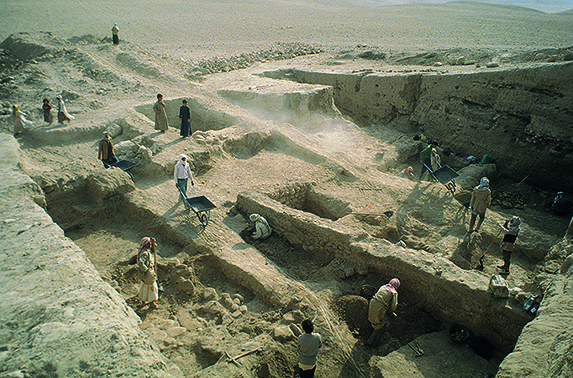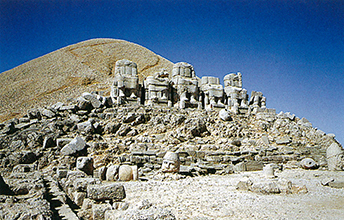The Ancient Orient Museum opened on 5th October 1978, as the first museum in Japan to specialise in the Ancient Orient. The Museum conducts research on various aspects of the Ancient Orient, and at the same time collects, conserves, and exhibits objects which have historical, artistic, and archaeological value for the public. Since its inception, we have undertaken several fieldwork projects in the Near/Middle East, and the collection houses a wide range of objects. Our collection at present contains more than five thousand objects from the Near/Middle East, Egypt, and other areas, ranging from the Palaeolithic to Islamic periods, as well as material excavated from Syria.
The Museum exhibition contains Museum Collections and Special Exhibitions, with several small-scale thematic exhibitions (Close-up Exhibitions) every year. Also public lectures by specialists and researchers from Japan and abroad, scientific symposia in collaboration with other institutions and museums and events for both adults and children during Special Exhibitions, are held frequently.
Research Activities
Since the establishment of the Museum, a series of excavations in Syria, Turkey, and Uzbekistan were carried out by the Museum, The museum has been studying the archaeology and art history of the Ancient Orient on the basis of these excavated materials, and undertaking curatorial research on museum objects.
Past Research Projects of the Ancient Orient Museum
1: Archaeological Investigations on the Euphrates (Rumeilah and Mishrifeh areas), Syrian Arab Republic (1974-1980)
The first exploration of the Ancient Orient Museum was undertaken in the late 1970's on the middle Euphrates where modern dam construction threatened ancient sites. Along with the investigations of Hellenistic and Byzantine tombs, major research emphasis was placed on a Bronze-Iron Age settlement of Tell Ali al-Hajj (also known as Tell Rumeilah) and a Roman fortress of Tell Mishrifat Hajj Ali Issa. At the same time many ancient remains and structures including Early Bronze Age graves were excavated during the field seasons. The excavations at Tell Ali al-Hajj were published in one volume (Memoirs of the Ancient Orient Museum vol. IV) in 2014.

Main excavation trench at Tell Ali al-Hajj
2: Excavations at Tell Mastuma, Syrian Arab Republic (1980-1995)
The excavations at Tell Mastuma, situated amid rich olive orchards in northwestern Syria near Idlib, were carried out by the Ancient Orient Museum from 1980 to 1995. Our investigations at this mound site revealed thick layers of occupation ranging from the Neolithic and Early Bronze Age to the Iron Age. Interestingly, an Iron Age village was almost fully exposed, and became one of the key sites in the region. The excavation results mainly concerned with this Iron Age village were published in Memoirs of the Ancient Orient Museum vol. III.

Aerial photo of Tell Mastuma during the excavations
3: Art Historical Survey of the Palmyran Sculptures, Syrian Arab Republic (1984)
Ancient Palmyra, flourished as one of the Greco-Roman caravan cities in the middle of the Syrian Desert, accumulated overwhelming wealth through international trade both from the West and the East. Based on such wealth, the city dwellers left various types of monumental architectures and funerary sculptures. In 1984, the Ancient Orient Museum carried out photographic documentations of the vast collection of Palmyran sculptures, and the results were published in Memoirs of the Ancient Orient Museum vol. I.

Limestone statue of a young lady from Shalamallat tomb (2nd century AD, Palmyra Museum)
4: Art Historical Survey of the Commagene Kingdom Sculptures, Republic of Turkey (1986-1987)
One of the Hellenistic local kingdoms, Commagene, prospered around the 1st century BC in eastern Anatolia. Numerous sculptures belonging to the kingdom period show a very unique Greco-Iranian style. In order to document the corpus of related sculptures, and fully understand the Hellenistic art within Near Eastern art history, we undertook a photographic survey. Valuable photographies are shown in the Memoirs of the Ancient Orient Museum vol. II.

Stone statues on the Eastern Terrace at Nemrut Dag (1st century BC)
5: Excavations at Dalverzin Tepa, Republic of Uzbekistan (1995-2001)
Dalverzin Tepa is an ancient citadel city on the Silk Road dating from the Greco-Bactrian, Kushan, to Early Medieval Periods. Our excavations focused on the citadel area, revealing the material culture of the 6th - 8th century AD.

Building remains of Level 2 at Dalverzin Tepa (6th - 7th century AD)
Curators and Researchers
Makiko Tsumura: Art and Archaeology of Cultural Exchanges between East and West.
Hidetoshi Tsumoto: Archaeological Study for Production Techniques and Cultural Transfer in West Asia.
Keiko Tazawa: Syro-Palestinian Deities in Ancient Egypt
Kazuya Shimogama: Archaeological Study for Transitional Periods in the Prehistoric and Historic West Asia.
Tae Takami: Educational Practice using the Ancient Orient Art
In addition, research fellows are currently affiliated with the Museum.
Museum Publications
ORIENTE
ORIENTE is the biannual magazine of the Museum containing short essays on the Ancient Orient, past lecture logs, and information on upcoming exhibitions. Members of the Museum receive two issues of ORIENTE every year mailed directly to their homes.
Bulletin of the Ancient Orient Museum
The Bulletin is a scientific periodical contributing to the study of archaeology, art history, iconography, and epigraphy of the Ancient Orient and Near/Middle East. Also included are our preliminary excavation reports in Syria and Uzbekistan as well as curatorial and material studies.
Memoirs of the Ancient Orient Museum
The volumes of the Memoirs are our scientific publications in English that report the results of our archaeological investigations, art-historical studies, and contribute to relevant research in the international scientific community.
Join our Museum Membership
For those who want to know more about the rich history and art of the Ancient Orient, and support our museum activities, our Museum Membership provides a wide range of benefits. Members receive free and unlimited access to our Museum Collections gallery and Special Exhibitions, as well as regular lectures (please note that Public Lectures "Jiyu-Gakkou" require additional charges). In addition, the Museum magazine ORIENTE is sent to every member. Members also receive a 10% discount at the Museum Shop, and invitations to exclusive experiences with our curators.
Public Lectures "Jiyu-Gakkou"
For those who want to know more about the rich history and art of the Ancient Orient, we have public lecture programmes by specialists (for Museum Members only).
 平成28年度 地域の核となる美術館・歴史博物館支援事業
平成28年度 地域の核となる美術館・歴史博物館支援事業







